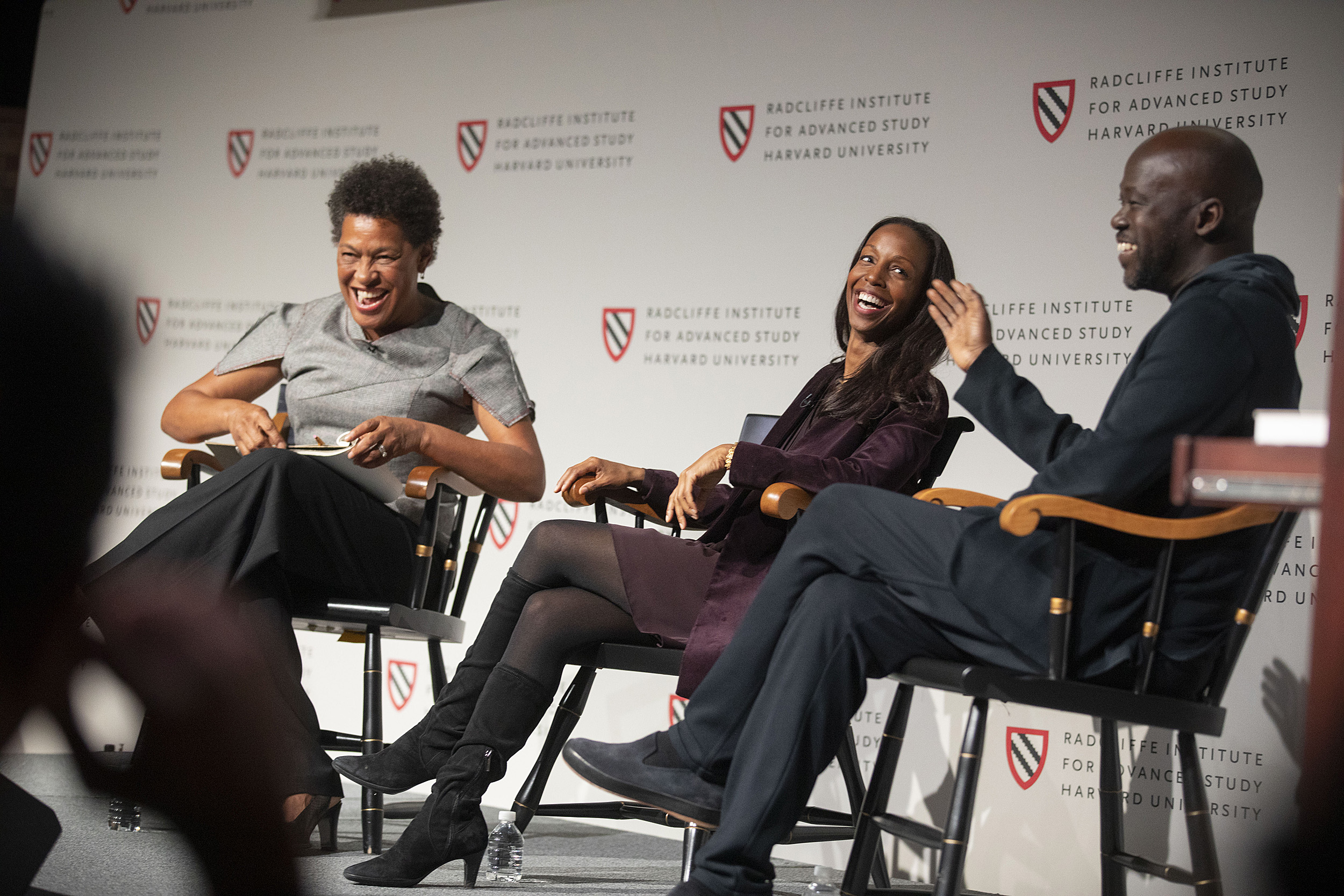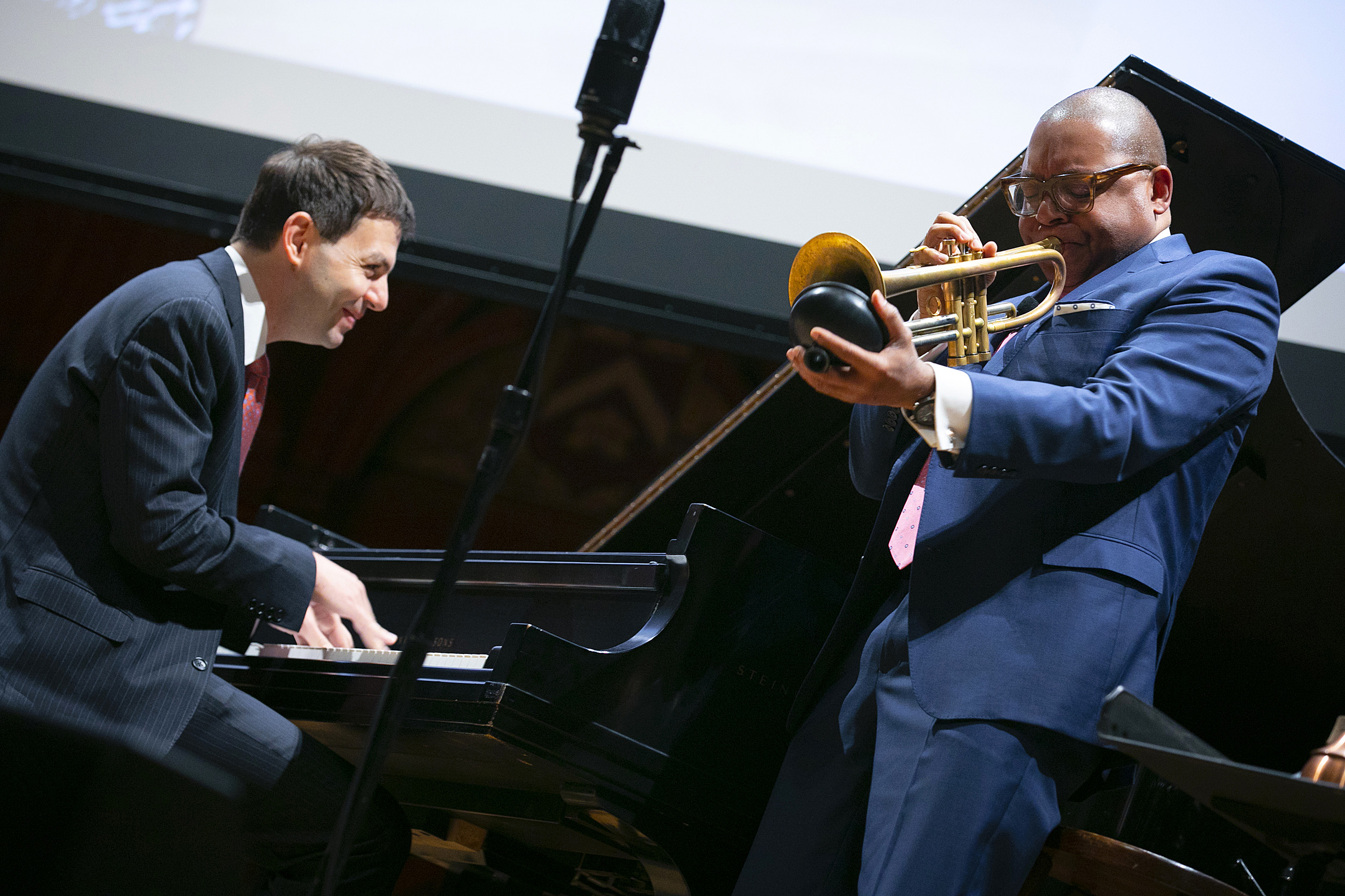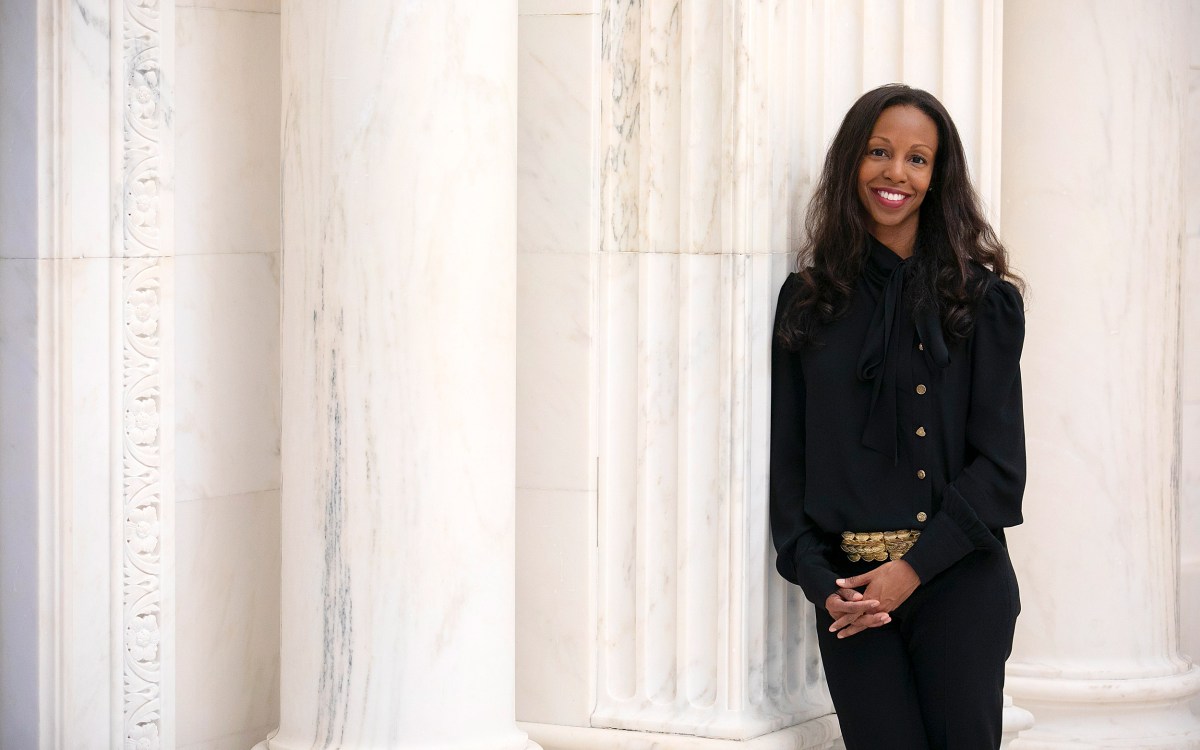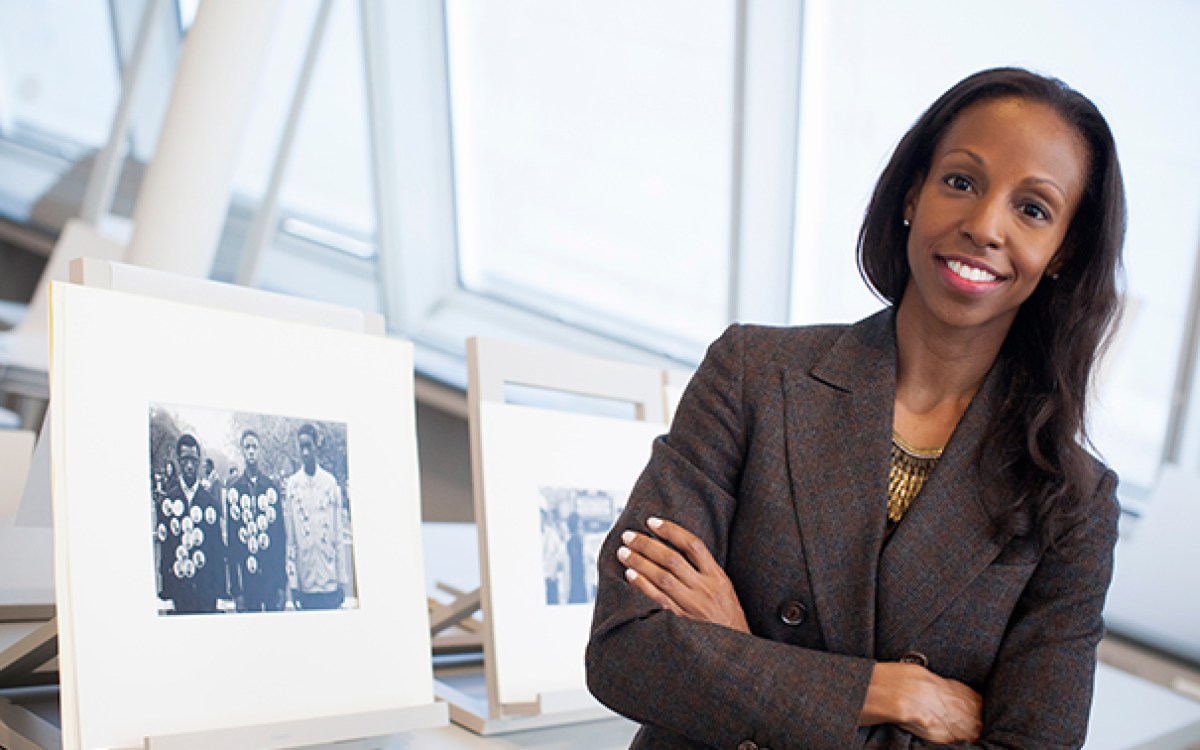
Panelists Carrie Mae Weems (from left), Sarah Lewis, and David Adjaye share a laugh onstage at the “Vision & Justice” conference.
Kris Snibbe/Harvard Staff Photographer
‘The work of culture alters our perceptions’
Radcliffe conference explores the nexus of race and justice through art
Diane Paulus considered it self-evident to put race at the center of the American Repertory Theater’s revival of the award-winning musical “1776,” debuting next year.
Speaking Friday at the “Vision & Justice” conference, Paulus, A.R.T.’s director, said earlier runs of the musical about the writing of the Declaration of Independence, failed to adequately depict how the nation’s founders dealt with slavery. “I thought, as an artist today, this makes me want to do the musical and look at who wasn’t included,” Paulus said. “It’s a great American tragedy.”
The conference brought together Paulus and other experts from Harvard and beyond to explore the role of the arts in citizenship, race, and justice. Participants included University President Larry Bacow, former University President Drew Faust, several Harvard deans, and prominent national figures including Chelsea Clinton, vice chair of the Clinton Foundation; musician Wynton Marsalis; student activist Naomi Wadler; rapper Kasseem Dean (Swizz Beatz); artist Carrie Mae Weems; and Henry Louis “Skip” Gates Jr., Alphonse Fletcher Jr. University Professor at Harvard and director of the Hutchins Center for African & African American Research. The conference concluded Friday evening with a keynote speech by Bryan Stevenson, J.D./M.P.P ’85, a professor of clinical law at New York University who in 1989 founded the Equal Justice Initiative.
The two-day conference, which was hosted by the Radcliffe Institute for Advanced Study at Harvard University, included panel discussions, musical performances, and videos and films at Sanders Theatre and the Radcliffe Institute’s Knafel Center.
Launched to consider the roles of art and culture in establishing the narratives of people of color, the conference was inspired by a course taught by Sarah Lewis ’97, assistant professor of history of art and architecture and African and African American studies, who also moderated parts of the event.
Lewis was drawn to the subject by her research of Frederick Douglass and his understanding of how art was used to manipulate public perception of African Americans. She said she was also inspired by her grandfather, who was once expelled from school for asking why there were no African Americans in the history books.
“The work of culture alters our perceptions,” said Lewis. “It connects us to the work of justice. How many movements have begun when a work of art, when culture, so shifted our perceptions of the world entirely that we had to conceive it anew? I think more times than we can possibly imagine.”
The conference began Thursday with opening remarks from Radcliffe Institute Dean Tomiko Brown-Nagin, after which the first session featured multidisciplinary artist Alexandra Bell, Columbia professor and New Yorker staff writer Jelani Cobb, Nicole Fleetwood of Rutgers University’s Department of Women’s and Gender Studies, and Harvard Art Museums’ Richard L. Menschel Curator of Photography Makeda Best discussing “Citizenship and Racial Narratives.” Later, Weems and Lewis were joined by architect David Adjaye to deliberate “Originality and Invention” before the afternoon wrapped up with performances by Weems and jazz pianist Vijay Iyer.
Friday morning began with welcoming remarks from Provost Alan M. Garber ’76, Ph.D. ’82, who said he hoped the conference would “provide new insights into power and culture and a broader understanding of race and justice in the United States.”
The day’s first panel, “Cultural Citizenship,” examined art’s ability to make people of color feel a sense of belonging. The panel was moderated by Drew Faust, president emerita of Harvard and the Arthur Kingsley Porter University Professor.
Following an opening performance, Marsalis suggested that jazz can be a metaphor for different kinds of people working together. “The drum is the loudest, the bass is the softest, the bass is the lowest, the cymbal the lightest, and they’re forced to deal with each other,” he said, explaining how musician improvise with one another.

During the morning session of the conference, Wynton Marsalis (right) performs a musical opening.
Stephanie Mitchell/Harvard Staff Photographer
Theater’s role, said Paulus, is to show “a world where we’re stuck and angry but hope for transformation. … The theater is always about the impossible becoming possible.”
Later in the morning, a panel on “Race, Culture, and Civic Space” considered the role of public spaces in race and justice. Artist Theaster Gates, founder and executive director of the Rebuild Foundation, which focuses on urban renewal in Chicago, said the proliferation of grim strip malls in urban areas impact people’s ability to be their “best selves.”
“Justice requires we not only have beautiful places in the downtown, we have beautiful places in the hood,” said Gates, a professor in the Department of Visual Arts at the University of Chicago.
Another panel focused on the Flint, Mich., water crisis. Mona Hanna-Attisha, the pediatrician, professor, and public health advocate credited with revealing that children there were being exposed to high levels of lead, told Clinton during an interview that officials neglected Flint but would not have ignored a majority white community.
“People chose to close their eyes to Flint,” Hanna-Attisha said.
The conference also tackled how people of color are portrayed in politics and the media. Although Hollywood is becoming more diverse, racial minorities remain dramatically underrepresented. Speaking on a panel titled “Race, Childhood, and Inequality in the Political Realm,” Yara Shahidi ’21, star of the ABC sitcoms “Black-ish” and “Grown-ish” and a Harvard University student, said that meaningful progress would come when TV and movies are made about people of color “doing nothing in particular.”
“To just exist on screen and for people to be hungry for that, that would mean a lot,” Shahidi said.
Wadler, a 12-year-old from Alexandria, Va., who protests gun violence, particularly against African American girls and women, called attention to the “adultification” of black girls, saying they are viewed as older and less innocent than white girls and, as a result, more responsible for their actions, resulting in harsher punishments.
Like Shahidi, Wadler said she wants to see people like her reflected in national institutions.
“I looked at the editorial board at The New York Times, and it was very white and male,” Wadler said. “I want to see a black female like myself.”
Friday also featured an interview of conceptual artist Hank Willis Thomas by Cheryl Finley, an associate professor of art history at Cornell University; a section on “Race, Technology, and Algorithmic Bias”; concluding remarks by Vincent Brown, Charles Warren Professor of History and a professor of African and African American studies; and a public reception at the Ethelbert Cooper Gallery of African and African American Art, which is currently exhibiting works by documentary photojournalist Gordon Parks from the collection of Dean and his wife, Alicia Keys.
“I don’t think slavery ended in 1865; I think it just evolved. It turned into decades of violence and terror and lynching. … And we haven’t talked about what that era of terrorism has done to us.”
Keynote speaker Bryan Stevenson
In his keynote address, Stevenson began with an extended personal anecdote about his experience with bigotry as a child, saying the nation must fully confront its painful history of slavery and racial violence if it is to become a truly just society.
“We cannot create justice in this country until we change the narrative. Until we create a new relationship to our history, I don’t believe we’re free in America,” said Stevenson. “Our artists and our storytellers and our historians are so critical to the struggle. We can’t have justice without poetry, without dance, without music, without art, without sculpture, without leaders who are finding ways to shift this narrative.”
Under Stevenson’s leadership, the Equal Justice Initiative has fought to exonerate death-row prisoners, confront abuses of the incarcerated mentally ill and others, and help children prosecuted as adults. He recently won a historic Supreme Court ruling banning mandatory life-without-parole sentences for children 17 or younger.
Last year, Stevenson led the creation of the National Memorial for Peace and Justice and the Legacy Museum in Montgomery, Ala., to honor victims of lynching in the South.
Stevenson said the greatest evil of American slavery was the “narrative of racial difference that was created to justify enslavement,” an extension of the bias used to justify genocide against Native Americans. He said that ideology of white supremacy endured even after slavery.
The 13th Amendment “talks about ending involuntary servitude and ending forced labor, but it doesn’t say anything about ending this narrative of racial differences. … I don’t think slavery ended in 1865; I think it just evolved,” he said. “It turned into decades of violence and terror and lynching. … And we haven’t talked about what that era of terrorism has done to us.”
The historic migration of millions of African Americans from the South is one legacy of that violence, Stevenson said, observing that blacks relocated to northern states not in search of economic opportunity but “as refugees and exiles from terror in the American South.”
Even the Civil Rights movement failed to eradicate the legacy of bias, Stevenson noted. He said it “breaks my heart” to have to tell Harvard students that even today, “If you’re black or brown your Harvard degree will not keep you from being presumed dangerous and guilty.”
Stevenson said South Africa, Rwanda, and Germany have recognized the need to remember and learn from the violence in their pasts, “but in this country we don’t talk about slavery, we don’t talk about lynching, we don’t talk about segregation.”
His intent is not to see the nation punished, he said. “What I’m interested in is liberation. I believe there’s something better waiting for us than what we’ve experienced. There’s something that feels like racial equality, that feels like justice, and it’s out there but we can’t get there till we change the narrative.”
Despite the challenges, Stevenson urged his listeners to remain upbeat, saying, “We cannot create justice without hope.”
Still, he cautioned that to succeed, “We’re going to have to be willing to do things that are uncomfortable.” He noted that he himself had endured times when, “I’ve just been completely shattered by inequality,” recalling the anguish he felt at the execution of an intellectually disabled death-row inmate whose life he had tried to save.
“The truth is when you try to change narratives, when you stand with the poor and the condemned,” he said, “there will be moments when you feel overwhelmed.” But he urged his listeners to join the fight. “You don’t have to be the most talented and gifted artist. But if you have a heart and a mind and a willingness to change narratives, if you’ve got some hope, if you’ll do some uncomfortable things, you will contribute to the justice quotient that we’re trying to create in this country.”






